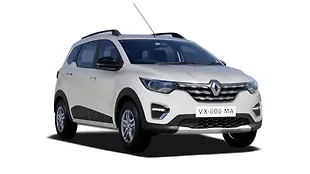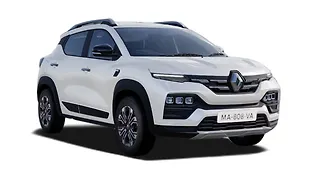What is it?

It is the revised and improved version of the SUV that started the avalanche of compact SUVs in the country; a segment that the Hyundai Creta is currently milking. The Creta had delivered a knockout punch to the Duster not just by winning every comparison test it entered, but by outselling the Renault Duster by a huge margin.

The latter isn’t taking this thrashing lying down, and now with its refreshed exterior, improved interior quality, more equipment and crucially, an affordable and efficient automatic gearbox, the Renault Duster is back with a vengeance.

The Duster was always a looker and the new one only looks even more macho and purposeful. The new large two-slat chrome grille looks aggressive and the front bumper now accommodates purposeful looking silver cladding with a chunky scuff plate. The highlight of the front design are the new headlamps.

Although there’s no daytime running function, these are highly detailed and lend the Duster’s masculine front some degree of technical appeal. From the side, the Duster remains mostly unchanged except for the new five-spoke black alloy wheels and integrated turn indicators in the ORVMs.

How is it on the inside?

We had always criticised the Duster’s cabin for it lacked a similar degree of premiumness as some of its rivals, especially Hyundai. With the facelift, Renault has tried to fix it by giving the Duster’s cabin revised design and finishes. The grey and brown dual-tone interior theme looks interesting and the centre console now gets a gloss-black finish. There are lots of changes on the centre console and it now extends all the way up to the air-vents giving it a more cohesive look.

The dated air-con controls are replaced by a more modern automatic climate control unit and the touchscreen unit is new too. Other changes include the embossed Duster logo above the glovebox and nice chrome surrounds for the air vents.Thankfully the mirror adjust knob is shifted from under the hand brake lever to a more conventional place.

Although ergonomics have improved, the Renault Duster still comes with some signature French quirks. The music system controls are still column mounted and hide behind the steering wheel; to operate cruise control you still have to use buttons on the centre console as well as the steering wheel; the infotainment system and AC controls are placed too low and the power windows switchboard is still hard-edged and fouls with your right knee. Even the quality overall – of the plastics in particular – still leave a lot to be desired; the cabin is still marred with hard and ill-fitting plastics.

What has vastly improved over the old car is the seat fabric. The upholstery on the top RxZ variant feels upmarket and the front seats are comfortable as well. Under thigh and back support is good but better seat contour would have been helped.

The seat height adjuster is still the irritating get-off-the-seat-and-adjust type though. At the rear, the Duster is quite spacious and the wide cabin makes sitting three abreast easy. The bench itself is set at a good height and there is decent back support.

The large 475-litre boot is cleverly shaped and makes the Duster a great weekend car. But in terms of in-cabin storage the Duster is a bit lacking. The door pockets are slim and the two cupholders in the centre console are too narrow and shallow.

You get more equipment with the upgraded Duster now. It gets rain-sensing wipers, driver’s side power window with one touch auto up and down function, automatic climate control and ESP for both the AMT and the AWD variants.
How is it to drive?

The Renault Duster comes with the same 1.5-litre dCi diesel powerplant in two states of tune – 84bhp and 109bhp. There’s also a 1.6-litre petrol engine mated to a five-speed manual gearbox. The biggest addition though is of the automated manual transmission (AMT) on the more powerful diesel version. Renault also claims to have improved the packaging of the engine bay and have strengthened it in key areas to improve safety.

The AMT gearbox is available in the top RxL and RxZ variants and comes only in front-wheel-drive guise. Let’s start with the positives. This is by far the best iteration of the AMT we have experienced till date, across makes. This ZF-sourced system works well on the highway and part throttle gearshifts are relatively smooth. You also get a creep function which is a boon in stop-start traffic.

But as soon as you put your foot down you get that typical AMT pause as the hydraulic actuators struggle to downshift quickly enough to keep up the momentum. Even in stop-start traffic, power delivery can be jerky and upshifts at lower speeds feel painstakingly slow. It’s in the manual mode that this gearbox feels the best and there is a way of getting around this drawback by just lifting off before every shift. Unfortunately, this defeats the whole purpose of having an automatic in the first place.

Despite the slow gearbox, performance figures are quite impressive with 100kmph coming up in 13.61 seconds. But it’s in the drivability test where the Duster AMT suffers as it takes 8.08 seconds for the 20-80kmph dash and 10.46 seconds in the 40-100kmph kickdown. This makes it nearly two seconds slower than the Hyundai Creta automatic on both drivability runs.

We also sampled the AWD version of the Duster and as before we came away really impressed. The AWD variant uses shorter gearing as compared to the 4X2 variant and this helps its drivability considerably. There is loads of pulling power from the word go and even at speeds as low as 20kmph you can easily pull away in third gear. Renault seems to have made the clutch lighter too which makes town driving a hassle free affair.

Even in terms of ride or through sweeping bends, the AWD version displays better composure as compared to the normal variant. This is mainly down to the more sophisticated independent rear suspension it uses and even the four-wheel-drive system provides loads of grip. The combination of the shorter gear ratios and a potent AWD system makes this SUV one of the best small off-roaders in our market.

But even the AMT variant with non-independent rear suspension has an impressive mix of comfort and agility. Apart from some body roll due to the high body, the Duster stays surefooted. The steering is direct and provides loads of feel. But like before, you get a violent kickback from the steering whenever you encounter mid-corner bumps which takes a bit away from the fun factor of this capable SUV. The well-judged suspension means the worst of roads don’t faze this Renault and you always feel comfortab no matter what the condition.
Should I buy one?

The Renault Duster was always an impressive product and now with the upgrade it’s better than before – interiors are plusher, there’s more standard equipment and it looks even more macho now. Plus, there’s the additional draw of an affordable automatic version. It still has its shortcomings, of course – for a car that costs Rs 15 lakh or thereabouts, the plastics needed to look and feel richer, and the AMT – with its slow-witted nature – just doesn’t cut it. A modern torque converter or a DCT gearbox would have been the right fit for this price. So, as we see it, the Duster to buy, continues to be the AWD variant. And it is in this trim with its added capability that it’s a great alternative to the Hyundai Creta.
Where does it fit in?

The Renault Duster’s key rival is the impressive Hyundai Creta. When compared spec-to-spec the Creta is slightly more expensive than the Renault. It even rivals the much larger and a lot more expensive Mahindra XUV 500.
Hyundai Creta AT Vs Mahindra XUV500 AT
Mahindra XUV500 AT first drive
Photos: Kapil Angane

![Renault Duster [2016-2019] Driving Renault Duster [2016-2019] Driving](https://imgd.aeplcdn.com/642x361/cw/ec/22616/Renault-Duster-Driving-69283.jpg?v=201711021421&wm=1&q=80)
![Renault Duster [2016-2019] Left Side View Renault Duster [2016-2019] Left Side View](https://imgd.aeplcdn.com/642x361/cw/ec/22616/Renault-Duster-Left-Side-View-69287.jpg?v=201711021421&wm=1&q=80)
![Renault Duster [2016-2019] Front View Renault Duster [2016-2019] Front View](https://imgd.aeplcdn.com/642x361/cw/ec/22616/Renault-Duster-Front-view-69284.jpg?v=201711021421&wm=1&q=80)
![Renault Duster [2016-2019] Front View Renault Duster [2016-2019] Front View](https://imgd.aeplcdn.com/642x361/cw/ec/22616/Renault-Duster-Front-view-69285.jpg?v=201711021421&wm=1&q=80)
![Renault Duster [2016-2019] Dashboard Renault Duster [2016-2019] Dashboard](https://imgd.aeplcdn.com/642x361/cw/ec/22616/Renault-Duster-Dashboard-69320.jpg?v=201711021421&wm=1&q=80)
![Renault Duster [2016-2019] Music System Renault Duster [2016-2019] Music System](https://imgd.aeplcdn.com/642x361/cw/ec/22616/Renault-Duster-Music-System-69316.jpg?v=201711021421&wm=1&q=80)
![Renault Duster [2016-2019] Interior Renault Duster [2016-2019] Interior](https://imgd.aeplcdn.com/642x361/cw/ec/22616/Renault-Duster-Interior-69329.jpg?v=201711021421&wm=1&q=80)
![Renault Duster [2016-2019] Interior Renault Duster [2016-2019] Interior](https://imgd.aeplcdn.com/642x361/cw/ec/22616/Renault-Duster-Interior-69330.jpg?v=201711021421&wm=1&q=80)
![Renault Duster [2016-2019] Image Renault Duster [2016-2019] Image](https://imgd.aeplcdn.com/272x153/cw/ec/22446/Renault-Duster-Exterior-118973.jpg?wm=0&q=80)
























